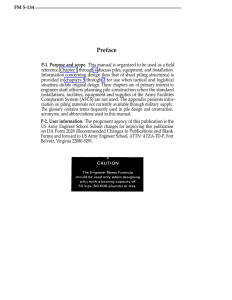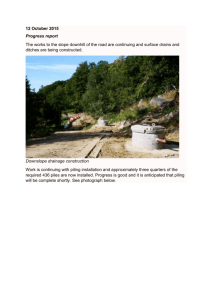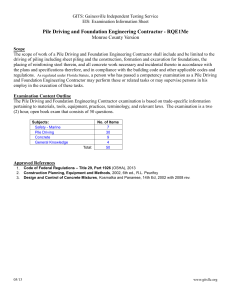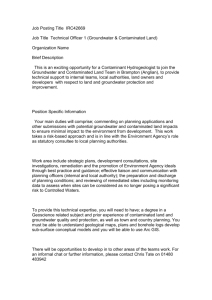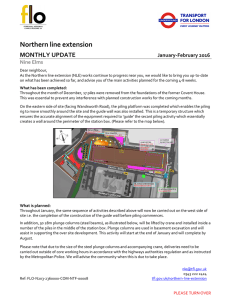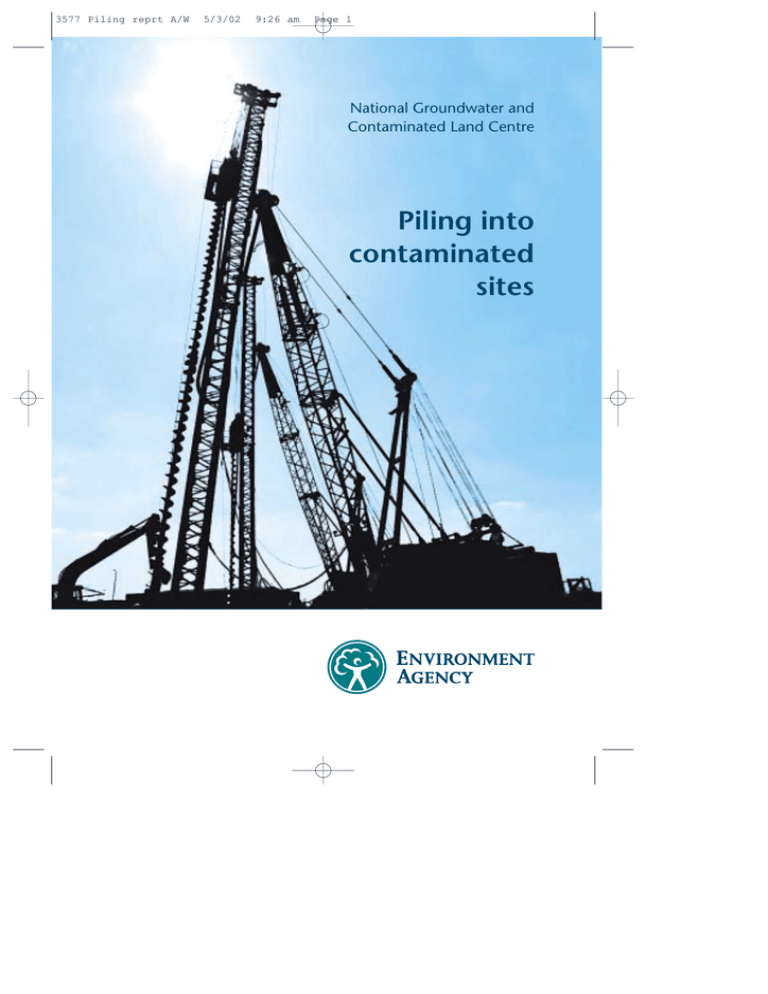
3577 Piling reprt A/W
5/3/02
9:26 am
Page 1
National Groundwater and
Contaminated Land Centre
Piling into
contaminated
sites
3577 Piling reprt A/W
5/3/02
9:26 am
Page 2
Published by:
Environment Agency,
Rio House,
Waterside Drive,
Aztec West,
Almondsbury,
Bristol BS32 4UD.
Tel: 01454 624 400
Fax: 01454 624 409
ISBN: 1 85705 803 8
© Environment Agency
All rights reserved. No part of this document may be reproduced,
stored in a retrieval system, or transmitted, in any form or by any
means, electronic, mechanical, photocopying, recording or
otherwise, without the prior permission of the Environment Agency.
Image reproduced courtesy of Keller Ground Engineering
3577 Piling reprt A/W
5/3/02
9:26 am
Page 1
Piling and penetrative ground improvement methods on land affected
by contamination: Summary guidance on pollution prevention.
Scope
This booklet summarises recent guidance1 produced by the Environment
Agency (the Agency), and gives a brief introduction to potential
environmental hazards associated with piling through contaminated soils,
and how sites may be improved. It focuses on the effects of piling on any
controlled waters, especially groundwater, with brief consideration of gas
and human health issues. It is not intended to provide comprehensive
information on all methods and site conditions but it is based on current
good practice.
1. Introduction
Piles are columnar elements in
foundations, which transfer loads from
structures through weak or
compressible strata, down to stronger
material capable of supporting the
loads. Penetrative ground
improvement techniques enhance the
bearing capacity of loose and
compressible soils, rendering them
suitable for shallow foundations.
Piling and penetrative ground
improvement methods are commonly
used on “brownfield sites”, where
previous development has resulted in a
thickness of loose or compressible soils
and “made” ground, which may be
contaminated. These methods typically
penetrate to greater depths than
standard foundations. Consequently,
they are likely to increase the risk of
contamination being transported by
creating new pathways.
1 Environment Agency (2001) Piling and Penetrative Ground Improvement Methods on Land Affected by
Contamination: Guidance on Pollution Prevention. NC/99/73
1
3577 Piling reprt A/W
5/3/02
9:26 am
The Agency recommends that piling
on contaminated sites underlain by
Page 2
2. Legislation and
regulatory context
aquifers is avoided where possible, and
that non-invasive methods, such as
rafts, should be used instead. Where
there is no alternative to piling, a
method should be selected that
minimises the risks of groundwater
pollution or gas migration. Mitigation
measures and/or environmental
monitoring may need to be
incorporated into the design. In such
circumstances the method selected
should be presented in a “Foundation
Works Risk Assessment Report” which
should summarise:
Redevelopment of land is generally
controlled through the Town and
Country Planning system. The Agency,
as a statutory consultee, provides
comments to the planning authority
on planning applications involving
contaminated land. The planning
authority is responsible for enforcing
any conditions concerning water
protection included in its decision
notice or other controls; for example
requiring a Foundation Works Risk
Assessment Report to be approved
before any works are undertaken.
●
the process of the assessment,
including the pollution scenarios
The Agency prefers to see the potential
that may occur using these
for pollution prevented through
techniques;
measures introduced via the planning
process, but there may be instances
●
the potential mitigation measures
where pollution of controlled waters is
that may be appropriate;
occurring or may occur. The Agency
has a number of powers under the
●
proposals for any monitoring;
●
particular problems and
It is an offence under section 85 of
uncertainties associated with the
WRA91 to “…cause or knowingly
methods chosen.
permit any poisonous, noxious or
2
Water Resources Act 1991 (WRA91).
3577 Piling reprt A/W
5/3/02
9:26 am
Page 3
polluting matter…to enter any
If waste (e.g. contaminated arisings
controlled waters”, which includes
from the piling works) is generated,
groundwater. Section 161 A-D of
there is a Duty of Care under Part II of
WRA91 and the Anti-Pollution Works
EPA 1990 on those responsible for the
Regulations 1999 give the Agency
waste, to ensure that it is managed and
powers to remedy or forestall pollution
transported properly, and disposed of
and serve “works notices” requiring
safely to an appropriately licensed
measures to protect or remediate
waste management facility.
controlled waters.
Part IIA of the Environmental
Protection Act (EPA) 1990 provides
a regime for the identification and
remediation of contaminated land.
It sets out a framework for
apportionment of liabilities for
remediation of contaminated sites,
which is based on the “polluter pays”
principle. Any person who causes or
knowingly permits contaminating
substances to be in or under the land
may be required to undertake
remediation and meet the costs; they
may also face prosecution.
3
3577 Piling reprt A/W
5/3/02
9:26 am
Page 4
3. Piling and penetrative
ground improvement
techniques
or may be cast in situ inside a casing or
Piling and penetrative ground
Non-displacement piling techniques,
improvement techniques have been
often called “bored” piling, extract a
split into three classes, based on the
core of soil and replace it with the pile,
installation method or the effect of the
which is typically formed by casting
installation on the soil mass. Piles can
concrete in situ. Displacement of the
be further subdivided according to the
surrounding soil is minimised.
construction and installation methods
Temporary support of the hole prior to
used (see Table 1).
placing the pile is often required.
Displacement piling
Displacement piling methods, also
General characteristics of
penetrative ground improvement
known as driven piling, form the pile
Penetrative ground improvement
by displacing soil horizontally from the
methods involve penetration of the full
space to be occupied by the pile,
thickness of the soil being improved,
without the removal of soil to the
up to a maximum depth of about 5
ground surface. The density of the soil
metres. A combination of densification
around the pile is increased and its
and the introduction of granular
permeability is reduced. Small
material to form stone columns may
displacement piles comprise steel
improve the physical (geotechnical)
sheet, H or I (in cross section), hollow
properties of the ground. Vibro
tube sections, or hybrids such as the
concrete columns are formed when
auger pile. Large displacement piles
concrete rather than granular material
include pre-cast concrete elements,
is introduced to the hole.
closed-end steel tube/timber sections,
4
in a pre-formed void.
Non-displacement piling
3577 Piling reprt A/W
5/3/02
9:26 am
Page 5
Table 1. Piling and penetrative ground improvement methods considered in
Report NC/99/73.
Generic method
Specific methods considered
Displacement piles
Pre-formed solid pile
Pre-formed hollow pile
Displacement cast-in-place pile
Non-displacement
(replacement) piles
Non-displacement cast-in-place pile
Partially pre-formed pile
Grout or concrete intruded pile
Penetrative ground
improvement methods
Vibro replacement stone column
improvement methods
Vibro concrete column (VCC)
Note: Refer to the guidance document1 for detailed information on the different piling and penetrative
ground improvement techniques and their environmental impacts.
4. Hazard identification:
potential adverse
environmental impacts
underlying strata, the proximity to
other receptors such as surface water
bodies, the history, use and occupation
of the site and its surroundings.
The Source–Pathway–Receptor (S-P-R)
linkages associated with piling and
In the case of piling and ground
ground improvement works must be
improvement works, concerns about
considered in a site-specific context.
water protection are likely to be most
acute when:
The presence of environmental
receptors that could be harmed by
●
contaminants are present on the
contaminants mobilised by ground
site and ground works could allow
works are defined by the
them to migrate;
hydrogeological properties of the
5
3577 Piling reprt A/W
●
5/3/02
9:26 am
Page 6
piling would breach an aquitard
The Agency’s response to proposals for
or connect two previously discrete
piling on contaminated sites will be
aquifers;
based on the overall level of risk that
piling presents, the techniques,
●
the site overlies a Major or Minor
Aquifer;
●
the site is located within a Source
Protection Zone (SPZ);
mitigation measures and the quality
assurance and control (QA/QC)
methods proposed. In sensitive
situations, the Agency may require a
risk assessment to be undertaken and
●
groundwater is currently of good
mitigation measures (including
quality;
groundwater monitoring) to be
incorporated. In the most sensitive
●
the water table is shallow or likely
to be intersected by piles;
●
the geological strata are fractured
or fissured;
●
situations, the Agency will object to
proposals that present an unacceptable
pollution risk.
The Agency has identified six potential
works are close to a surface water
pollution scenarios that are of
body and run-off from arisings
particular concern. These are described
could pollute those waters.
in Table 2 together with the S-P-R
linkages for each scenario.
6
3577 Piling reprt A/W
5/3/02
9:26 am
Page 7
Table 2. Pollution scenarios and summary of the Source–Pathway–Receptor linkages
Pollution Scenario 1
Source –
Creation of preferential pathways
through an aquitard to allow potential
contamination of an aquifer
contaminated made ground, waste or
contaminated perched groundwater
Pathway –
pile/stone column, pile/soil interface or
disturbed ground around pile
Typical cross section
Receptor –
groundwater in aquifer; typically in solid
strata in which pile is founded
Contaminated
ground or waste
Examples –
Pile,
VCC
or
stone
column
Aquitard (low
permeability) or
basal landfill liner
Aquifer as
founding stratum
1) contaminated ground above clay
deposits, which sit on permeable solid strata
such as the Chalk. Disturbance of aquitard
layer could create a migration pathway for
contaminated perched water in the made
ground
2) similar to 1) above: a closed landfill with a
basal liner, to be redeveloped, with structural
loads supported on piles founded in
permeable solid strata below the basal liner
Issues to consider
●
Polluting substances – leachable/mobile form?
●
Groundwater – directly beneath the site/in strata penetrated by piles/Major or Minor
Aquifer/in hydraulic continuity with a surface water body?
●
Aquitard/Aquifer – Will the piling or ground improvement method breach aquitard/the
basal liner of a landfill site/penetrate an aquifer?
●
Migration – Could contaminants in near surface deposits migrate into underlying
aquifer or surface water body?
●
Pile material – Is the pile made out of a material that could allow passage of
contaminants?
●
Preferential flowpath – Will the piling or ground improvement method create a flow path
for migration of contaminated perched water/leachate into an aquifer/surface water body?
7
3577 Piling reprt A/W
5/3/02
9:27 am
Page 8
Pollution Scenario 2
Source –
Creation of preferential pathways
through a low permeability surface layer,
allowing migration of landfill gas, soil gas
or contaminant vapours to the surface
gassing landfilled waste or contaminated
ground
Pathway –
pile/stone column, pile/soil interface or
disturbed ground around pile
Typical cross section
Receptor –
users of built development/structures
Low permeability
cap
Pile
VCC or
stone
column
Waste or gassing
contaminated soil
Founding stratum
Examples –
1) development on old landfill, or
“brownfield” site when ground levels have
been raised using gas-generating fill.
Disturbance of an impermeable capping
layer installed to manage the existing
gassing regime may create migration
pathways for landfill gas, air-flow pathways
rendering a gas extraction system
ineffective or increase the rate of
degradation and volume of gas generated
2) similar to 1) above: where land has been
contaminated with volatile compounds,
such as petroleum spirit
Issues to consider
●
Polluting substances/gas – Is the contamination present a potential source of landfill
gas or vapours?
●
Preferential flowpath – Will the piling or ground improvement method create a flow
path for the migration of gas/vapour to surface?
●
Gas risk – Is there a risk from accumulation of gas/vapours in enclosed spaces in the
proposed development? Will they be mitigated by using standard gas protection
measures?
●
Air quality – Are gas releases to atmosphere acceptable?
8
3577 Piling reprt A/W
5/3/02
9:27 am
Page 9
Pollution Scenario 3
Source –
Direct contact of site workers and others
with contaminated soil arisings that have
been brought to the surface
contaminated soil or waste
Pathway –
direct contact with excavated arisings, runoff to surface waters
Typical cross section
Receptor –
Spoil
Isolation layer/cap
human receptors (construction workers, site
users, etc) and surface water
Examples –
Pile
Waste or
contaminated soil
Founding stratum
1) piling creates arisings which contain
contamination that could come into contact
with sensitive receptors. The piling process
is likely to mix contaminated and
uncontaminated soils, producing an
increased volume of contaminated materials
for disposal. Contaminated piling arisings
may also cause cross-contamination to
isolated layers
Issues to consider
●
Contamination hazard – Are contaminants present in the soil/groundwater at sufficient
concentrations to pose a hazard to human health or the environment?
●
Arisings – Could the piling or ground improvement method bring potentially
contaminated soil arisings to the surface?
●
Disposal – Are measures in place to contain/dispose of arisings in a safe manner?
9
3577 Piling reprt A/W
5/3/02
9:27 am
Page 10
Pollution Scenario 4
Source –
Direct contact of the piles or engineered
structures with contaminated soil or
leachate causing degradation of materials
contaminated soil, waste or leachate
Pathway –
direct contact with pile
Typical cross section
Receptor –
built development (and users)
Examples –
Pile
VCC or
stone
column
Contaminated
soil or waste
(aggressive
conditions)
1) some contaminants in soil/leachate may
be aggressive to pile materials causing
degradation of piles, reducing or
eliminating their load carrying capacity, and
possibly creating further migration
pathways
Founding stratum
Issues to consider
●
10
Degradation – Do the soils or their leachability present a risk to the performance or
durability of the pile material?
3577 Piling reprt A/W
5/3/02
9:27 am
Page 11
Pollution Scenario 5
Source –
The pushing of solid contaminants down
into an aquifer during pile driving
contaminated soil
Pathway –
driving down of soil in contact with the
sides/butt end of pile, or “plugging” of
open-ended pile
Typical cross section
Receptor –
Contaminated
ground or waste
Driven
Pile
Aquitard (low
permeability) or
basal landfill liner
groundwater in aquifer, typically in solid
strata in which pile is founded
Examples –
1) soil in contact with the sides of a driven
pile and material below the butt end of a
solid or closed-end pile dragged down
Aquifer as
founding stratum
Contaminated soil
2) open-ended tubular piles become
“plugged” with soil, enabling material
captured near the surface to be transported
downwards within the tube towards the
founding level
Issues to consider
●
Polluting substances – leachable/mobile form?
●
Groundwater – directly beneath the site/in strata penetrated by piles/Major or Minor
Aquifer/in hydraulic continuity with a surface water body?
●
Aquitard/Aquifer – Will the piling or ground improvement method breach aquitard/the
basal liner of a landfill site/penetrate an aquifer?
●
Drag down – Does the piling method involve the use of blunt-ended solid or closedend piles that could drag down soil or open-ended tubular piles that could become
“plugged” with soil?
11
3577 Piling reprt A/W
5/3/02
9:27 am
Page 12
Pollution Scenario 6
Source –
Contamination of groundwater and,
subsequently, surface waters by wet
concrete, cement paste or grout
concrete, cement paste or grout introduced
to the ground
Pathway –
flow within highly permeable or fractured
strata
Typical cross section
Receptor –
Concrete/cement paste/grout
groundwater and surface water
Pile
or
VCC
Soft strata
To groundwater
and surface
water source
Fractured or
permeable strata
Examples –
1) loss of wet concrete, cement paste or
grout in fast-flowing groundwater,
associated with fractured/jointed rocks e.g.
limestones, Chalk or permeable gravel
formations. If retardant additives are used
pile materials could take several hours to set.
Issues to consider
●
Contamination – Does the method involve introducing wet concrete, cement paste or
grout into the ground?
●
Groundwater – directly beneath the site/in strata penetrated by piles/Major or Minor
Aquifer/in hydraulic continuity with a surface water body?
●
Aquifer – Highly fissured or granular strata? Is the groundwater in the aquifer fastflowing?
Note: Other scenarios may be identified in particular circumstances.
12
3577 Piling reprt A/W
5/3/02
9:27 am
5. Hazard assessment
The potential for piling techniques to
cause pollution should be considered
and the likely environmental
consequences estimated. This will
require an understanding of sitespecific conditions (e.g. hydrogeology,
contaminant properties, piling
Page 13
recommended risk assessment process
is given in Figure 1. It provides a
framework for risk assessment method
selection and appropriate QA/QC
measures. This can be presented in a
“Foundation Works Risk Assessment
Report” (see Table 3 for suggested
contents).
implacement methods) and through
The removal of potentially adverse
risk assessment will allow estimation of
impacts will normally be achieved
the scale of potential problems and
through specific mitigation measures
direct design of any mitigation
(e.g. changes to the installation
measures.
method). A number of issues to be
It is often helpful to develop a
‘conceptual model’ of the site, and
considered are:
●
do the mitigation measures
how the ground works could affect the
themselves have any adverse
environment.
environmental impacts?
6. Recommended risk
assessment framework
●
are the mitigation measures
adequate to remove significant
adverse environmental impacts?
The risk assessment framework
proposes a decision-making process
●
be specified to ensure that they
that indicates where piling is
are incorporated and verified
unacceptable or allows selection of
during the installation works?
appropriate piling methods and
mitigation measures (see guidance
document1
for further details). The
how will the mitigation measures
●
what monitoring requirements
are there?
13
3577 Piling reprt A/W
●
5/3/02
9:27 am
Page 14
who will verify the inclusion and
adequacy of the mitigation
measures?
●
could subsequent building works
adversely affect the mitigation
measures and how will this be
prevented?
Table 3. Suggested contents of Foundation Works Risk Assessment Report
1. Introduction: describing the site setting including geology, hydrogeology,
soil or groundwater contamination, topography, geotechnical
considerations and requirements for piling or ground improvement
methods.
2. Initial selection of piling method: Justification of the preferred method.
3. Identification of potential adverse environmental impacts.
4. Site-specific assessment of the identified risks to the environment, workers
and end users.
5. Identification of any changes to preferred method. Consideration of
mitigation measures that may be required.
6. Identification of QA/QC methods and measures.
7. Justification of selected methodology: including mitigation, QA/QC and
monitoring measures, with regard to geotechnical, financial and
environmental considerations.
14
3577 Piling reprt A/W
5/3/02
9:27 am
Determine initial preferred piling* method
on structural, geotechnical and commercial
considerations
Page 15
Figure 1. Risk assessment flowchart
Is the site affected by contamination of soil or
groundwater?✝
Yes
No
Confirm piling* method
Are there any potential adverse environmental
impacts which could be affected or created by
proposed piling* method?
Yes
No
Are there practical alternative construction
methods that avoid the pollution hazard?
(e.g construction of buildings on rafts)
No
Yes
Use method that avoids hazard
Carry out risk assessment
Are any of the potential adverse environmental
impacts considered to be significant?
Yes
No
Consider mitigation measures
Are mitigation measures adequate to remove
significant adverse environmental impacts?
No
Yes
Consider alternative foundation solution or
piling* method
Determine QA/QC procedures
necessary for verification of
mitigation measures
Prepare Foundation Works Risk Assessment
report
Confirm that there are no objections from
the Environment Agency
Incorporate mitigation measures into
piling* design/specification
Incorporate QA/QC procedures into
piling* design/specification
* (or penetrative ground improvement)
✝ consultation with the Agency is advised at the
state of assessing environment sensitivity of site.
Ensure waste management issues are
addressed
Confirm piling* method
15
3577 Piling reprt A/W
5/3/02
9:27 am
Page 16
Useful further reading
Environment Agency (1996) Pollution
Environment Agency (2000b)
Prevention Manual. Internal guidance
Introducing Environmental Risk
document.
Assessment.
National Centre for Risk Analysis and
Environment Agency (1998)
Options Appraisal.
Policy & Practice for the Protection of
Groundwater.
Environment Agency (2000c)
The Stationery Office.
Guidance for the safe development of
housing on land affected by
Environment Agency (1999)
Methodology for the derivation of
remedial targets for soil and groundwater
contamination.
R&D Publication 66. The Stationery
Office.
to protect water resources.
R&D Publication 20.
Environment Agency (2001)
Piling and Penetrative Ground
Environment Agency (2000a)
Risks of contaminated land to buildings,
building materials and services:
A literature review.
R&D Technical Report P331.
Improvement Methods on Land Affected
by Contamination: Guidance on Pollution
Prevention.
National Groundwater &
Contaminated Land Centre, Project
NC/99/73. Solihull.
More information
The National Groundwater and Contaminated Land Centre’s Vision is: an improved
groundwater and land environment for present and future generations.
Further National Centre reports and other booklets in this series are available from
the Agency website: www.environment-agency.gov.uk
Published February 2002
16
3577 Piling reprt A/W
5/3/02
9:27 am
Page 17
3577 Piling reprt A/W
5/3/02
9:27 am
Page a
CONTACTS:
THE ENVIRONMENT AGENCY HEAD OFFICE
Rio House, Waterside Drive, Aztec West, Almondsbury, Bristol BS32 4UD.
Tel: 01454 624 400 Fax: 01454 624 409
www.environment-agency.gov.uk
www.environment-agency.wales.gov.uk
NATIONAL GROUNDWATER & CONTAMINATED LAND CENTRE
Olton Court, 10 Warwick Road, Olton, Solihull B92 7HX.
Tel: 0121 711 5885 Fax: 0121 711 5925
E-mail: ngwclc@environment-agency.gov.uk
ENVIRONMENT AGENCY REGIONAL OFFICES
ANGLIAN
Kingfisher House
Goldhay Way
Orton Goldhay
Peterborough PE2 5ZR
Tel: 01733 371 811
Fax: 01733 231 840
SOUTHERN
Guildbourne House
Chatsworth Road
Worthing
West Sussex BN11 1LD
Tel: 01903 832 000
Fax: 01903 821 832
MIDLANDS
Sapphire East
550 Streetsbrook Road
Solihull B91 1QT
Tel: 0121 711 2324
Fax: 0121 711 5824
SOUTH WEST
Manley House
Kestrel Way
Exeter EX2 7LQ
Tel: 01392 444 000
Fax: 01392 444 238
NORTH EAST
Rivers House
21 Park Square South
Leeds LS1 2QG
Tel: 0113 244 0191
Fax: 0113 246 1889
THAMES
Kings Meadow House
Kings Meadow Road
Reading RG1 8DQ
Tel: 0118 953 5000
Fax: 0118 950 0388
NORTH WEST
Richard Fairclough House
Knutsford Road
Warrington WA4 1HG
Tel: 01925 653 999
Fax: 01925 415 961
WALES
Rivers House/Plas-yr-Afon
St Mellons Business Park
St Mellons
Cardiff CF3 0EY
Tel: 029 2077 0088
Fax: 029 2079 8555
NORTH
WEST
NORTH
EAST
Leeds
Warrington
MIDLANDS
Peterborough
ANGLIAN
Solihull
WALES
THAMES
Cardiff
Bristol
SOUTH WEST
London
Reading
Worthing
SOUTHERN
Exeter
E NVI RONM E N T AGE NCY
GE NE RAL E NQUI RY LI NE
0845 933 3111
0845 988 1188
E NVI RONM E N T AGE NCY
EME RGENCY HOTLINE
0800 80 70 60
HO-02/02-1.8K-C-POD Printed on Revive
E NVI RONM E N T AGE NCY
F L O O D L I N E

